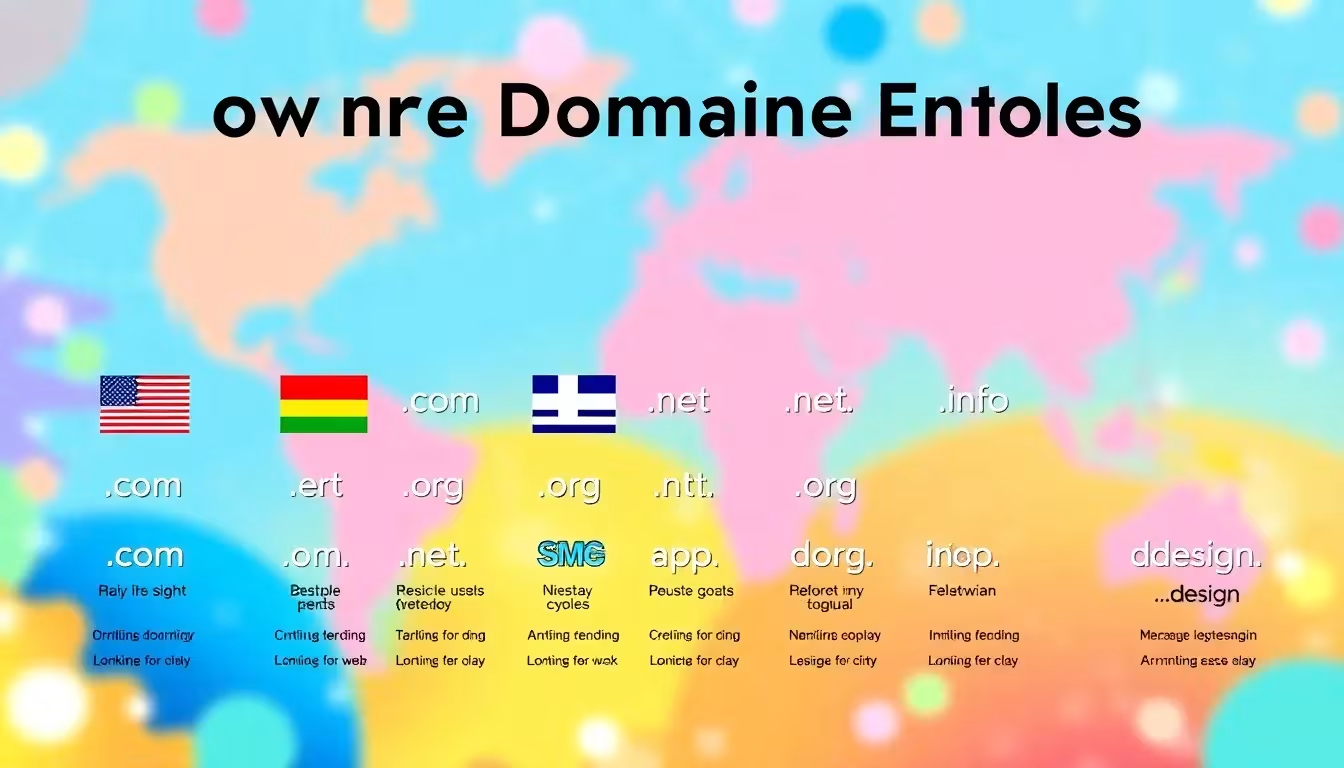Choosing the right Domain extension contributes significantly to the success of an online project. It influences the findability in search engines, generates trust among users and provides information on the orientation of your offer.
Key points
- Geographical allocation: Country-specific endings build trust with local target groups.
- Brand strategy: New gTLDs such as .store or .tech strengthen branding.
- Search engine effect: The domain extension influences local SEO and click rate.
- cost structure: Large price differences depending on the extension and provider.
- Legal situation: Trademark rights must be observed for domain names.

What does the domain extension mean technically and strategically?
The Domain extension - officially referred to as a top-level domain - is technically at the end of a web address, but in fact at the beginning of digital credibility. While .com represents the global standard for business websites, .de immediately signals a regional and confidential orientation to visitors from Germany.
Country-specific TLDs (ccTLDs) such as .de or .ch look familiar and improve the positioning in Google and Co. for local search queries. I particularly recommend them for projects with a regional focus. Generic endings (.com, .net, .org), on the other hand, work excellently for international projects, such as global online stores or digital tools in the SaaS environment.
The choice should not be based on preference alone - but on clear considerations about the use of your site, your main target audience and your digital brand architecture.
Classic vs. new domain extensions
While classic endings such as .de or .com are often the first choice, new generic top-level domains (new gTLDs) such as .design or .app are becoming increasingly important - especially for specialized projects. These offer concise communication advantages in branding.
For example, an online gallery with the ending .art immediately makes its focus clear, a domain such as startup.tech demonstrates innovative strength. But beware: despite the creative options, many of these endings are still little known. Skeptical users or email filters can devalue them.
Niche endings offer opportunities - and certain risks. If you are looking for professionalism, you should combine them with a well-known extension or communicate them clearly on social media channels.

SEO and domain extension - what really counts?
Google treats endings as technically equivalent. But in the local SEO the TLD plays a role. A .de extension tends to be displayed to users in Germany rather than .com domains - provided the rest of the content is SEO-optimized.
I have observed in projects that the domain extension influences the click-through rate (CTR) in search results. Users are more likely to click on familiar endings. Even if the domain with .com has a strong ranking, .de can generate stronger user loyalty in Germany.
However, a complete SEO advantage can only be achieved by taking a holistic view of the domain name, content, loading speed and link structure - the extension is one component among many, but a relevant one.
These criteria have a decisive influence on the choice
For all projects, I recommend checking the following criteria before deciding on a domain extension. A well-founded choice will save you having to make changes or incur high costs for expensive domains later on:
- Target region: Locally oriented projects usually perform better with country-specific endings.
- Internationality: For international traffic, a .com or possibly .org is worthwhile.
- Industry: If you have a creative company or digital platform, gTLDs such as .design or .media are a good choice.
- Brand communication: The domain extension should match the language, tone and offer of your website.
- Budget: Check the price for domain purchase and annual fees.

Comparison of popular domain extensions at a glance
For easier orientation, you will find a comparison table of the most popular domain extensions according to use, price level and suitability:
| Domain extension | SEO relevance local | International suitability | Confidence level | Average annual price (€) |
|---|---|---|---|---|
| .de | High | Limited | Very high | 8-12 |
| .com | Good | Very high | Very high | 9-15 |
| .org | Medium | Good | High | 10-14 |
| .store | Good | Good | Medium | 25-35 |
| .tech | Medium | High | New, growing | 20-40 |

How do I find out if my desired domain is still available?
Use domain check tools to check availability. In just a few seconds, they will show you whether startup.de or fashion.store is available, for example. I like to use platforms like Checkdomain tips & providersbecause alternative domain endings are also displayed there.
If your desired domain is taken, consider switching to a new gTLD - or check whether the domain is available for purchase. Sometimes a slightly different play on words is also worthwhile.
Protect domain extension - act legally correct
Before you register a domain, you should make sure that the name does not infringe a registered trademark. It can be very expensive if a trademark owner later takes action against you. I specifically check trademark rights in official databases before registration.
For well-known terms or company names, you should secure additional domains with other endings - for example .com, .de and .net. This will prevent competitors or third parties from weakening your digital presence.

Multiple domain extensions and subdomains: When is it worth it?
In my projects, the question often arises as to whether several domain endings make sense at the same time. Companies with a multilingual or international customer base in particular sometimes have different requirements for domain presences. For example, you could set up a .de domain for the German market and have a separate .com variant for English-speaking users.
In this case, it makes sense to host the main page on a country-specific domain and also use subdomains or referral domains for other regions. The decision ultimately depends on the time and costs involved: maintaining multiple endings also means higher maintenance costs for SEO, content updates and security. Nevertheless, I have observed that searchers from different countries are targeted more effectively this way. In some sectors - such as tourism or SaaS services - this additional effort can clearly be worthwhile.
Subdomains such as blog.example.com or store.yourcompany.com also offer the opportunity to clearly delineate thematic areas. This can also have SEO advantages if the subdomain is well structured. For beginners, however, it is often advisable to first establish a main domain with a suitable extension before adding several variants. A later roll-out to other domain extensions is still possible.
Technical aspects: DNS management and SSL certificates
In practice, managing multiple domain extensions raises questions about DNS configuration. Each domain requires an entry with a registrar to which information such as A records or MX records are transmitted. To ensure that emails and websites function correctly, these entries should always be checked and, if necessary, updated. I usually do this via my hoster's central dashboard so that I don't lose track.
Security is just as important: a valid SSL certificate should be available for every domain and subdomain that is publicly accessible. This creates trust among users and sends a positive signal to search engines. Let's Encrypt certificates are a cost-effective and widely used solution here. For larger projects, however, it is advisable to use a so-called wildcard certificate to secure several subdomains at the same time. In my projects, I often use a combination of standard certificates and wildcard solutions, depending on the scope of the domain strategy.
Domain strategy and brand development: How does the extension fit into the overall concept?
A domain extension is more than just a technical appendix. It contributes significantly to the perception of your brand. I recommend coordinating the website, the social media handles and the domain extension. For example, it creates recognition value if the brand name is not too complex and is used in both the social networks and the domain.
Especially in creative fields - for example design agencies or photography portfolios - a suitable gTLD can strengthen the brand identity. The advantages are obvious: users immediately recognize the subject area and you can place your brand name without any disruptive additions. However, I recommend always using a well-known TLD such as .com or .de as a backup so as not to scare off traditionally oriented users. In some target groups, a domain extension that is too unusual can cause uncertainty.
To drive brand building forward, you should also check whether your company or product name is still available on social networks. It would be unwise to rely on a wonderful domain such as projekt.design if the Instagram or TikTok handle of the same name is occupied by another brand. A consistent brand presence is one of the strongest factors for long-term success online.
Internationalization and language: The right domain extension for global markets
The choice of language on your website should be closely linked to the respective domain extension. A .de extension conveys familiarity to users in Germany, Austria or parts of Switzerland, but can lead to confusion in English-speaking countries. Conversely, users often expect English content with a .com extension. In my projects, I therefore often separate country-specific content and use different domains instead of relying solely on language tags or subfolders (e.g. /de/ or /en/).
However, if you only want to create individual subpages for different languages, you can continue to use a single generic ending (.com, .net etc.) and manage the language versions via subdirectories or subdomains. The choice depends heavily on how extensive the multilingual offering is. A purely bilingual blog can work well with a single .com domain. Large e-commerce projects, on the other hand, often benefit from a clear division per country-specific TLD. In this case, the domain extension creates a feeling of proximity and trust among users.
Offline marketing and the importance of a catchy domain
A memorable domain extension can be a great advantage not only online, but also in offline marketing. Whether on flyers, business cards, advertising posters or vehicle lettering: The shorter and clearer the web address is, the greater the chance that prospective customers will remember it. I have noticed time and again that exotic or complicated TLDs quickly cause confusion offline - especially when potential visitors have to enter the address using a cell phone keypad.
For this reason, it makes sense to have alternative domain endings ready in case one ending is not easy to market. You can then point to the more common domain for offline advertising, while online the specialized TLD can continue to play a role for branding or SEO. This creates a kind of "best of both worlds" where you don't have to give up your original brand identity and still reach the masses of habitual users.
Domain security and long-term maintenance
Especially after you have found and registered your own domain, you should not only focus on the start, but also think about long-term maintenance. I recommend renewing your domain in good time and paying attention to possible security gaps. Activate locking options (domain lock) so that the domain cannot be transferred unintentionally.
Regular backups of your website and careful maintenance of DNS entries are also part of this. A small oversight in the configuration can quickly lead to emails not being delivered or the website being unavailable for hours (or even days). I therefore schedule fixed maintenance intervals in my projects to ensure that the domain, hosting and CMS always work together optimally. This pays off - not least in terms of customer trust and the stability of your online presence.
Registering a domain extension - procedure and tips
Once you have decided on a domain extension, registration usually takes just a few minutes. Via platforms such as our step-by-step guide secure your desired domain permanently. Important: Pay attention to transparent prices and conditions for renewals when purchasing.
Many providers offer combined packages with e-mail, hosting or security certificates - check whether you would like to book these directly.

Final thoughts on the choice of domain extension
The perfect domain extension does not guarantee success - but it does strengthen your findability, professionalism and user appeal. If the brand name, technical structure and extension match, your website will be convincing from the very first URL. I never make domain decisions on the spur of the moment - but on the basis of clear key figures, user behavior and project goals.
Whether it's a new extension or a classic TLD - adapt the domain extension to your project, not the other way around. And if you want to keep an eye on current trends, I recommend my article on Domain trends 2025.



